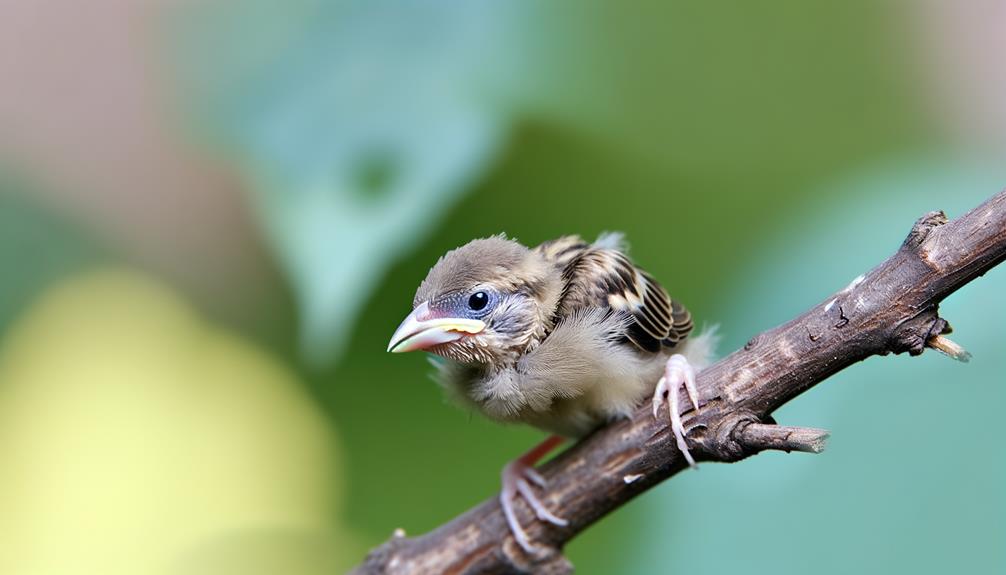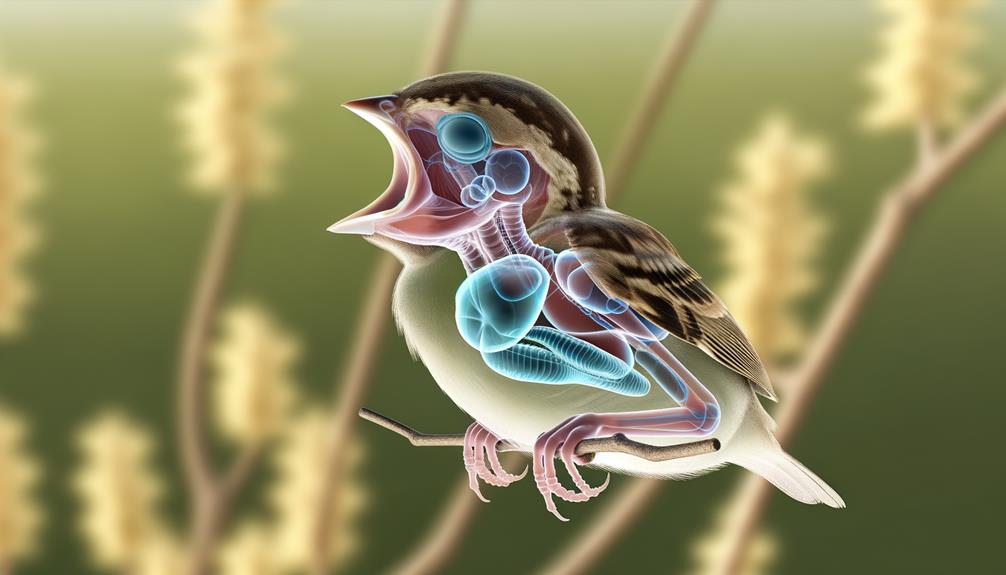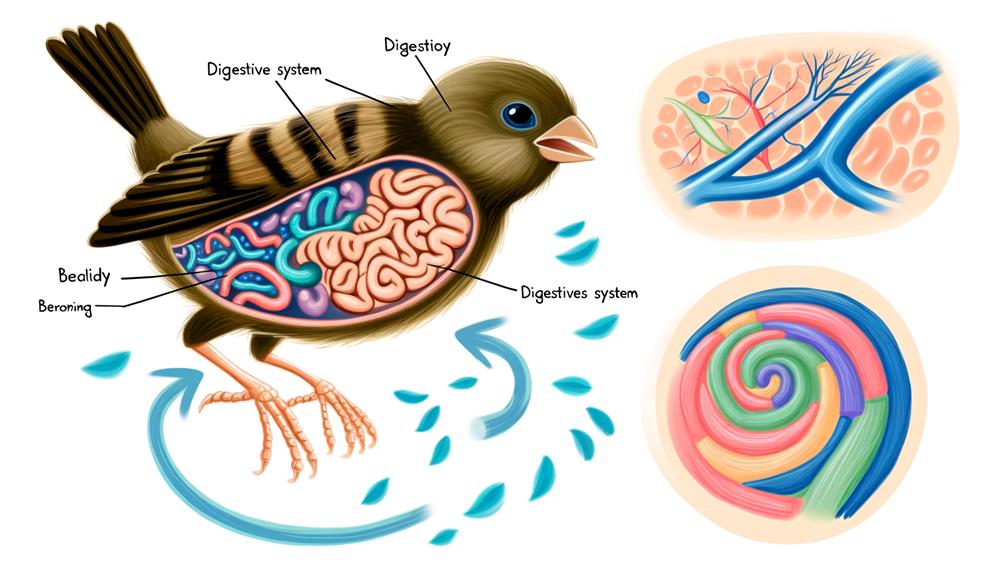Do Baby Sparrows Whistle Out Their Butt?
Baby sparrows don't whistle out their butt. This myth likely stems from misinterpreting their rapid tail movements while they vocalize.
Sparrows produce sounds through their syrinx, a specialized vocal organ located at the base of their trachea. The syrinx allows them to create complex sounds used for communication, such as chirps and calls.
Observations show that their vocal mechanisms are similar to many other bird species, relying on muscle and membrane vibrations to generate sound. Exploring the authentic vocal and non-vocal communication methods used by sparrows reveals the fascinating intricacies of their behavior.

Key Takeaways
- Baby sparrows do not whistle from their butt; they produce sounds via their syrinx.
- The myth arose from misinterpreted behaviors like rapid tail movements while vocalizing.
- Ornithologists confirm sparrows' vocalizations come from specialized vocal structures, not their posterior.
- Vocal sounds are created through the syrinx by modulating airflow and muscle vibrations.
- Dispelling such myths requires evidence-based observations and understanding of avian anatomy.
The Origin of the Myth

The myth of baby sparrows whistling out their butt likely originated from a combination of misinterpreted avian behaviors and anthropomorphic storytelling. You might've observed baby sparrows engaging in rapid, rhythmic tail movements while vocalizing. This could lead to the false assumption that the sounds emanate from their posterior.
Additionally, the anthropomorphic tendency to attribute human-like traits to animals can create whimsical but inaccurate narratives. While serving others, it's pivotal to dispel such myths by relying on evidence-based observations.
Ornithologists confirm that sparrows, like other birds, produce sounds via their syrinx, located at the base of their trachea. Understanding the true mechanisms of bird vocalization helps you educate others accurately and prevents the spread of misinformation.
Sparrow Communication Basics
Sparrows utilize a complex system of vocalizations, including chirps, whistles, and trills, to communicate a variety of messages within their social groups. You'll notice these sounds serve different functions:
- Alarm Calls: High-pitched and rapid, warning others of predators.
- Territorial Songs: Melodious and repetitive, used by males to assert dominance and attract mates.
- Begging Calls: Short and incessant, employed by chicks requesting food from parents.
Observations reveal that these vocalizations are essential for maintaining social structure and ensuring survival. Research indicates that sparrows can recognize individual calls, demonstrating advanced auditory discrimination.
Anatomy of Sparrow Sounds

Understanding the anatomy of sparrow sounds involves examining the specialized vocal structures that enable these birds to produce their diverse array of calls. You'll find that the key component is the syrinx, located at the base of a sparrow's trachea.
This unique organ, unlike the human larynx, allows for complex sound modulation. The syrinx has specialized muscles and membranes that vibrate to create sound. Airflow from the lungs passes through the syrinx, and the tension of the membranes can be adjusted to produce different pitches and tones.
Additionally, the muscles surrounding the syrinx can change the shape of the vocal tract, further refining the sounds. This intricate system ensures sparrows can effectively communicate with one another.
Vocal Vs. Non-Vocal Sounds
You need to understand the distinction between vocal communication mechanisms and non-vocal sound production in baby sparrows. Vocal sounds originate from the syrinx, allowing for complex calls and songs, while non-vocal sounds may result from mechanical actions like feather or body movements.
Evidence shows that both types of sounds play essential roles in sparrow communication and behavior.
Vocal Communication Mechanisms
In analyzing the vocal communication mechanisms of birds, particularly sparrows, one must distinguish between vocal sounds produced through the syrinx and non-vocal sounds generated by other body parts.
The syrinx, located at the base of a bird's trachea, is the primary organ for vocalization. It's capable of producing complex and varied sounds essential for communication.
Consider the following:
- Syrinx: Produces melodious chirps and calls.
- Feathers: Used in fluttering to create non-vocal sounds.
- Beak: Clicks and snaps can supplement vocal communication.
Understanding these mechanisms helps you appreciate the complexity of avian communication.
Evidence shows that sparrows use their syrinx for essential communication tasks like mating calls and territory defense, demonstrating their reliance on vocal mechanisms.
Non-Vocal Sound Production
While the syrinx remains the sparrow's primary tool for vocal communication, they also rely on non-vocal sound production to convey messages and interact with their environment.
You might observe sparrows using wing flapping, tail flicking, and beak snapping as mechanisms to produce sounds. These non-vocal signals often serve as alarm calls or mating rituals.
Research indicates that the intensity and frequency of wing flapping can signal the presence of predators, alerting fellow sparrows. Additionally, tail flicking can communicate agitation or readiness to mate.
Each non-vocal sound plays an essential role in a sparrow's survival and social interaction. Understanding these behaviors can help you better serve and protect these avian species, ensuring their habitats remain conducive to their complex communication needs.
How Birds Produce Sound

You'll find that birds produce sound primarily through a specialized vocal organ called the syrinx, located at the base of their trachea.
Detailed observations show that the syrinx's unique structure allows intricate control over pitch and volume by adjusting the tension of its labia and the airflow.
Evidence-based research indicates that this mechanism enables birds to create a vast array of sounds, from melodious songs to complex calls.
Syrinx: Bird Vocal Organ
The syrinx, located at the base of a bird's trachea, serves as the primary organ for sound production, enabling birds to create a diverse range of vocalizations through specialized muscle control and airflow regulation.
Understanding the syrinx involves attention to detail:
- Anatomy: The syrinx is composed of intricate cartilaginous rings and soft tissues.
- Musculature: Specialized muscles finely adjust tension and position.
- Airflow: Air passing through the syrinx vibrates the tissues to produce sound.
Sound Production Mechanism
Through precise coordination of muscle contractions and airflow, birds generate their wide array of vocalizations by manipulating the syrinx's structures.
You'll find that the syrinx, located at the base of a bird's trachea, houses specialized muscles that control the tension of the labia. As air passes through, these muscles adjust the labia's position, producing different pitches and tones.
Research indicates that birds can simultaneously control both sides of the syrinx, allowing complex and harmonious sounds. For baby sparrows, this process is critical in learning songs. Observational studies show that young birds practice these muscle movements to perfect their calls.
Understanding this intricate mechanism not only fascinates but also offers insight into avian communication, aiding in bird conservation efforts.
Respiratory System in Birds
Understanding how birds breathe reveals a marvel of biological engineering, characterized by a highly efficient respiratory system that supports their energetic lifestyles.
You'll find that birds don't just use their lungs; they employ a complex system of air sacs and unidirectional airflow to maximize oxygen extraction.
Key components include:
- Air Sacs: These structures store and move air through the respiratory system, ensuring a constant flow of oxygen.
- Unidirectional Airflow: Unlike mammals, birds have air flowing in one direction through their lungs, which increases gas exchange efficiency.
- Crosscurrent Exchange: Blood flows perpendicular to the airflow, allowing for higher oxygen uptake.
This system allows birds to sustain high activity levels, aiding their flight and metabolic demands.
Digestive System Function

In examining a bird's digestive system, you'll find a specialized and efficient series of organs tailored to their dietary needs and rapid metabolism.
The digestive tract begins with the beak, where food intake occurs. Once swallowed, food travels down the esophagus to the crop for temporary storage.
The stomach has two parts: the proventriculus, where digestive enzymes are secreted, and the gizzard, which grinds food with the aid of ingested grit.
Nutrient absorption happens in the small intestine, while the large intestine is relatively short, leading directly to the cloaca.
This system ensures quick processing, essential for maintaining energy levels in baby sparrows. Understanding these functions helps in caring for avian species effectively, fostering their growth and health.
Comparison With Other Birds
Unlike baby sparrows, many bird species have a more complex digestive system with additional adaptations for their specific dietary habits. When you examine other birds, you'll see varying levels of complexity and specialization:
- Owls: They've a two-chambered stomach, allowing them to process indigestible parts like bones and fur separately.
- Hummingbirds: Their rapid metabolism requires a highly efficient digestive system to quickly convert nectar into energy.
- Herons: Specialized beaks and elongated throats enable them to catch and swallow large fish whole.
These adaptations reveal how different avian species have evolved to meet their unique nutritional needs efficiently.
Scientific Studies and Findings
Recent research into avian physiology has uncovered fascinating insights into how baby sparrows, despite their seemingly simple digestive systems, exhibit unique adaptations that enable their survival and growth.
Studies show that their cloaca, a multipurpose opening, is highly efficient in expelling waste and facilitating reproductive functions. Observations reveal that baby sparrows produce distinctive sounds, but these are generated through their vocal cords, not their cloaca. Investigations using endoscopic techniques confirm that the cloaca remains closed during vocalizations.
This evidence suggests that the physiological structures of baby sparrows are optimized for their developmental needs. By understanding these mechanisms, you can better appreciate the sophisticated adaptations that contribute to the wellbeing and continuity of avian species.
Debunking the Myth
Many bird enthusiasts have perpetuated the myth that baby sparrows whistle through their cloaca, but scientific evidence unequivocally debunks this misconception.
Observations and anatomical studies reveal:
- Vocal Mechanism: Baby sparrows use a specialized vocal organ called the syrinx, located at the base of their trachea, to produce sounds.
- Auditory Analysis: Spectrograms show that the frequency and modulation of sparrow calls align with air passing through the syrinx, not the cloaca.
- Physiological Constraints: The cloaca primarily serves excretory and reproductive functions, lacking the anatomical structures necessary for sound production.
Conclusion
To wrap up, baby sparrows don't whistle out their butts. Instead, they rely on their syrinx, located at the base of their trachea, to produce sound.
Surprisingly, studies show that around 5,000 bird species use this specialized organ for vocalization. This detailed understanding debunks the myth and highlights the complexity of avian communication.
So, next time you hear a baby sparrow, appreciate the intricate anatomy at play rather than the amusing but false notion of butt whistling.






